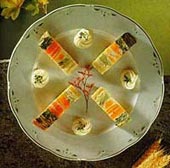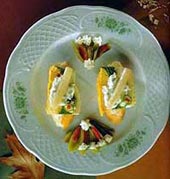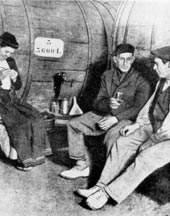Feeding nationalism (I/II)
Difficult to think of something more central to our lives than food. For we digest symbols and myths as much as fats, proteins, and carbohydrates. At one and the same time food is both nutrition and a mode of thought. It enables us biologically, and structures our life socially. As both fuel for our bodies and ideas for our minds, food is common to every single one of us.
Given this, it is all the more surprising that a recognizable ‘food studies’ did not arise within academia until the closing decade of the last century. Economists and geographers might have paid attention to its production and distribution but the great majority of political scientists, historians, sociologists, and literary critics stubbornly avoided serious work into the topic. Even anthropologists outside of Third World village settings tended to quietly pass over it. For reasons which are still unclear, these attitudes have dramatically reversed, and today a host of academics from a range of disciplines produce monographs, textbooks and readers in this new field, edit book series, hold conferences in it, and head organizations dedicated to its furtherance, such as the Association for the Study of Food and Society, in the USA, or the seminal Oxford Food Symposium, in the UK. They have come to realize the insights a study of food and foodways can give.1

In some societies the foods valued and the ways they are prepared are codified into a cuisine, which may even become a central symbol of the society itself. In this way a discourse of food and food practices, open to multiple interpretations, can assist in both the construction and sustaining of national community. Locals may laud this everyday mode of nationalism; some politicians may come on board as well. For they know that turning foodstuffs and dishes into bearers of national identity is a down-to-earth way to make an otherwise abstract ideology more familiar, domestic, even palatable. France is the famed exemplar here.2
The topic of this chapter is another well-known, well-regarded cuisine -the Basque one- internationally lauded yet strikingly little-studied in a critical manner. In the following, I investigate how an idea of Basque cuisine arose, what it entails, how it has evolved, who uses the term, and for what reasons. I regard this chapter as a still all-too rare contribution to the study of the political dimension of national cuisines.3
‘Basque cuisine’ today
 An
idea of ‘Basque cuisine’ could come to the fore because a cultural
version of Spanish nationalism has, in the modern period,
been so weak. Since the Revolution, a particular version of ‘French
cuisine’ has been a central part of French national identity.4
There has been no comparable process in Spain. Instead regional cuisines have
been able to gain a defined identity and the most successful of those is the
Basque one. And today, there is little chance of the contemporary idea of
‘Basque cuisine’ declining in prominence in the Basque Country,
for a number of very good reasons, primarily political and economic.
An
idea of ‘Basque cuisine’ could come to the fore because a cultural
version of Spanish nationalism has, in the modern period,
been so weak. Since the Revolution, a particular version of ‘French
cuisine’ has been a central part of French national identity.4
There has been no comparable process in Spain. Instead regional cuisines have
been able to gain a defined identity and the most successful of those is the
Basque one. And today, there is little chance of the contemporary idea of
‘Basque cuisine’ declining in prominence in the Basque Country,
for a number of very good reasons, primarily political and economic.
First, as the Basque Government knows well, Basque cuisine is a good image to tout. An integral part of the Government’s recent tourist campaigns both within Spain and beyond, Basque cuisine is promoted as a quality product, with dishes as traditional as weather-beaten Basque homesteads and as sophisticated as the Bilbao Guggenheim. This package of food, art and futurist architecture, aimed at an upmarket tourism, is also a necessary counterweight to the bad press caused by the continuing efforts of Basque terrorists. It is a way of reminding outsiders that there is much more to the area than gunmen and radical political activity. As the Government Department for Industry, Commerce and Tourism puts it, in its promotional literature:
Gastronomy is as much part of the Basque Country as the green of its mountains, the sea breaking on its coast, its language, or its folklore. Its cuisine has developed since the most ancient of times, parallel with the arrival of visitors to the country. Ever since the ‘belle époque’, Basque cuisine has been celebrated throughout the entire world.
Today, with the culture of leisure installed among us, Basque products, cuisine and gastronomy have become the ambassadors of a way of doing things. It would be difficult to understand present-day Basque culture without the ludo-gastronomic concept linked to the offer of our country.5
 It
is for these reasons that Basque authorities subsidize the building of museums
dedicated to local cheeses or cider, and why they are disposed to sponsor
tours ‘from Kenya to Mexico, from Yugoslavia to Japan’ by the
more renowned of the nueva cocina chefs, demonstrating their
art to all who wish to listen. In the process these chefs
come to be seen as ‘ambassadors of the Basque people whose cuisine has
begun to be much heard of in international dining rooms’.6
The leader of the Basque Government expressed this sentiment so:
It
is for these reasons that Basque authorities subsidize the building of museums
dedicated to local cheeses or cider, and why they are disposed to sponsor
tours ‘from Kenya to Mexico, from Yugoslavia to Japan’ by the
more renowned of the nueva cocina chefs, demonstrating their
art to all who wish to listen. In the process these chefs
come to be seen as ‘ambassadors of the Basque people whose cuisine has
begun to be much heard of in international dining rooms’.6
The leader of the Basque Government expressed this sentiment so:
‘I have observed with pleasure these past years that there have been numerous culinary embassies which have travelled to other countries, carriers, not only of how to cook well, but also of the friendly image of our people.
...I see with pleasure this expansion of the Basque cuisine and I am proud of the women and men who, with their work, have managed to create an extremely important pole of tourist attraction.’7
The Basque Government now funds the annual Euskadi Prizes of Gastronomy and its leading politicians are assiduous in attending a variety of promotional events for Basque foods, cider and wines. Given this interested publicity for modern Basque cuisine and its leading lights, any criticism of its renowned chefs becomes all the more damning. Thus, when in October 2004, four of them were publicly charged with paying ETA’s ‘impuesto revolucionario’ (‘revolutionary tax’), anti-nationalist journalists made much of the fact: ‘To feed ETA’ and ‘Nurturing the monster’ were just two of the subsequent headlines.8
 Second,
nationalists of all political shades may themselves see Basque cuisine and
its customs as a way to unify, possibly even to pacify local society. When
a local journalist asked one leading representative of the PNV about civil
confrontation in contemporary Basque society, he responded
that there were ‘things which bring people together, like Athletic de
Bilbao, the Real Sociedad (local football teams) and the sidrerías’,
which have been enjoying a revival since the 1980s.9
It is illuminating that Francisco Letamendía, a famous radical nationalist
during the transition towards democracy, has co-argued that ‘In a country
torn by social and political division, culinary culture...
will be one of the links of union, perhaps the most unquestionable, which
will make brothers of all the Basques, over and above their differences’.10
Furthermore Egin never once criticized the owners of Zalacaian, a
Basque restaurant in Madrid and the most garlanded eatery in the country,
even though the only consumers who can afford to go there are the very biggest
of big capitalists. Indeed Basque cuisine is now so established a part of
Basque identity that it may act as a legitimator of it. In 2004, when interviewed
by a Basque journalist, a local film director, keen to emphasize his local
roots and down-to-earth nature, made a particular point of stressing that
one of his favorite pastimes was to cook traditional Basque dishes.
Second,
nationalists of all political shades may themselves see Basque cuisine and
its customs as a way to unify, possibly even to pacify local society. When
a local journalist asked one leading representative of the PNV about civil
confrontation in contemporary Basque society, he responded
that there were ‘things which bring people together, like Athletic de
Bilbao, the Real Sociedad (local football teams) and the sidrerías’,
which have been enjoying a revival since the 1980s.9
It is illuminating that Francisco Letamendía, a famous radical nationalist
during the transition towards democracy, has co-argued that ‘In a country
torn by social and political division, culinary culture...
will be one of the links of union, perhaps the most unquestionable, which
will make brothers of all the Basques, over and above their differences’.10
Furthermore Egin never once criticized the owners of Zalacaian, a
Basque restaurant in Madrid and the most garlanded eatery in the country,
even though the only consumers who can afford to go there are the very biggest
of big capitalists. Indeed Basque cuisine is now so established a part of
Basque identity that it may act as a legitimator of it. In 2004, when interviewed
by a Basque journalist, a local film director, keen to emphasize his local
roots and down-to-earth nature, made a particular point of stressing that
one of his favorite pastimes was to cook traditional Basque dishes.
To this list of the links made between politics and cuisine must be added the use of Basque dishes as metaphors for the political process itself. Here it is as though regional modes of culinary preparation can themselves stand in for the local style of social relations. Thus in 2002 when a Bilbao writer and journalist wished to criticize the PNV and the local church for their conniving pusillanimity, he wrote:
While ETA, with great inner peace, prepared its dynamite debut, Basque blame thickened slowly and carefully, like a green sauce of bacalao al pil-pil in the stoves of the batzokis (PNV club-premises), and like a red sauce of bacalao a la vizcaína in the church altars of Euskadi. The reddish and tomatoey blame of those apprehensive for the killings, for which they are not responsible. The greenish and oily blame of the nationalists looking towards an unborn nation, which neutralizes any other blame... Both kinds of blame fusing together in the same cooking-pot and, following the miraculous recipe of bacalao al Club Ranero, the product of a kitchen porter’s mistake, but which is now repeated in the National Table (a place of negotiation for nationalists), with the premeditation, nocturnality, and forethought malice of a clergyman with a bruised nose and a big gut.11
1 Possible reasons for the rise in interest in food are discussed in MacClancy 1992: 209-213. I am also a founding trustee of the Oxford Food Symposium Trust.
2 E.g. Zeldin 1980; Trubek 2000; Ferguson 2004. On politicians and cuisine see Coulon 2000.
3 Examples of this genre are Wilk 1993; Gabaccia 1998; Pilcher 1998; Zubaida and Tapper 2000.
4 On the reasons for this, see Zeldin 1980; Trubek 2000.
5 ‘La magie de la Gastronomie Basque’, Euskadi. Pays Basque. Avec plaisir, Servicio Central de Publicaciones del Gobierno Vasco, Departamento de Industria, Comercio y Turismo, August 2003, p3.
6 Lapitz 1983 ; Gipuzkotour magazine Spring 2006 : 12 ; Gara 13 v 2006, ‘Sagardo botila’ suppl., p.4.
7 Ardanza 1987: 13.
8 El Mundo 17 x 2004.
9 El Mundo 2 x 2000: 11.
10 Iturbe and Letamendía 2000: 76.
11 Ezkerra 2002: 128—29.
euskonews@euskonews.com
